Current challenges limiting the effectiveness of clinical oncologic imaging and therapeutic nanoparticle probes:
(i) Advance suitable particle probe designs with favorable safety, PK, and clearance profiles for achieving efficacious outcomes.
(ii) Maximize tissue contrast and detection sensitivity for optimal staging and treatment planning.
(iii) Achieve adequate target-specific delivery and localization with high resolution imaging tools.
(iv) Enhance solid tumor penetration, distribution, and retention of drug delivery vehicles over the native drugs themselves while reducing off-target effects.
(v) Improving overall treatment responses and local immunity via targeted remodeling of the microenvironment.
Figures
Improving pharmacokinetic (PK) properties, safety, and targeted delivery in melanoma patient
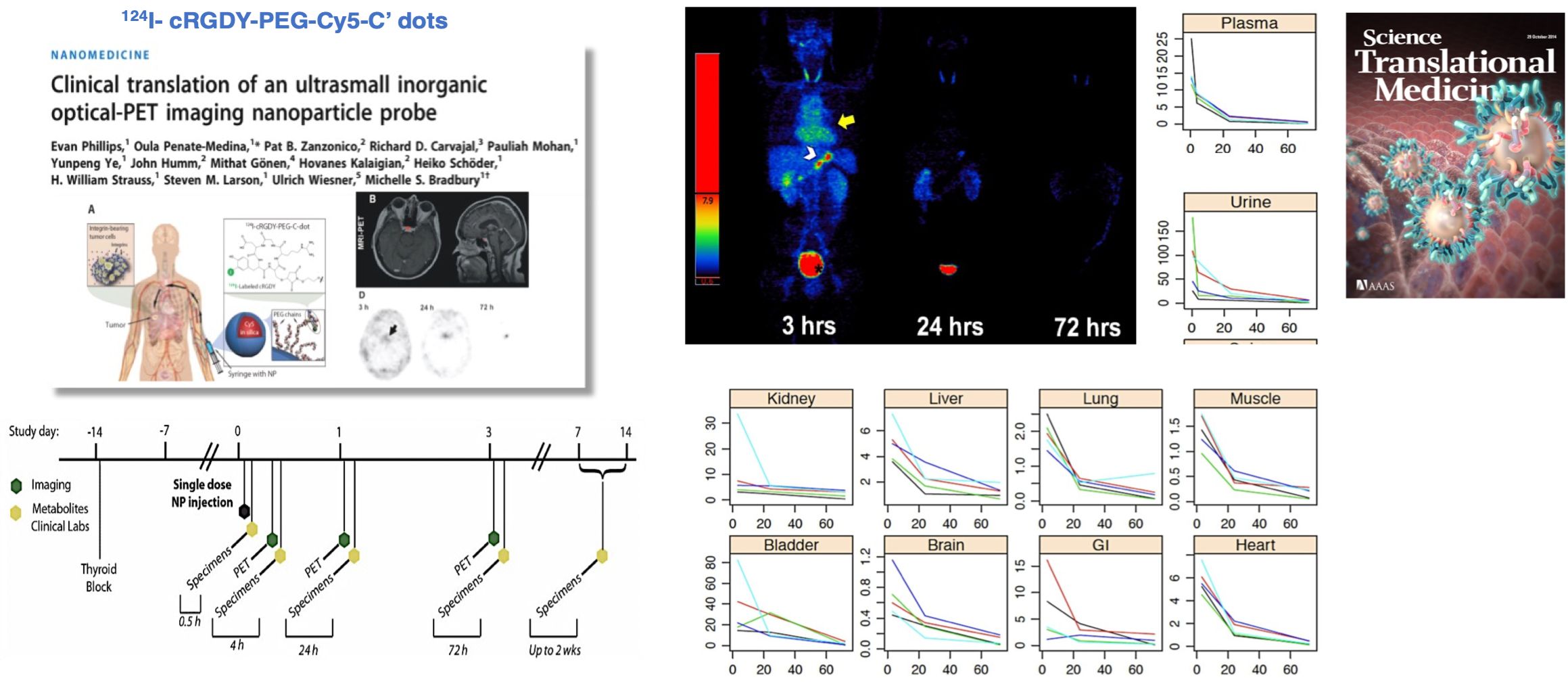
Figure 1. Favorable PET pharmacokinetic data is shown over time using a novel 124I-labeled integrin-targeting particle platform, 124I-cRGDY-PEG-Cy5-C’ dots, that was FDA cleared for a first-in-human clinical trial. A principal aim of this trial was to demonstrate improved product safety of this targeted multimodal platform in metastatic melanoma patients, along with targeted delivery as a secondary objective. C’ dots are ~6 nm hydrodynamic diameter designed for bulk renal clearance as part of a target-or-clear paradigm. E. Phillips, P. Zanzonico, J. Humm, S. Larson, U. Wiesner, M. Bradbury et al. Sci Trans Med 6, 260ra149 (2014)
Targeted Particle Delivery, Penetration, and Diffusion of Particles in Human Malignant Brain Tumors
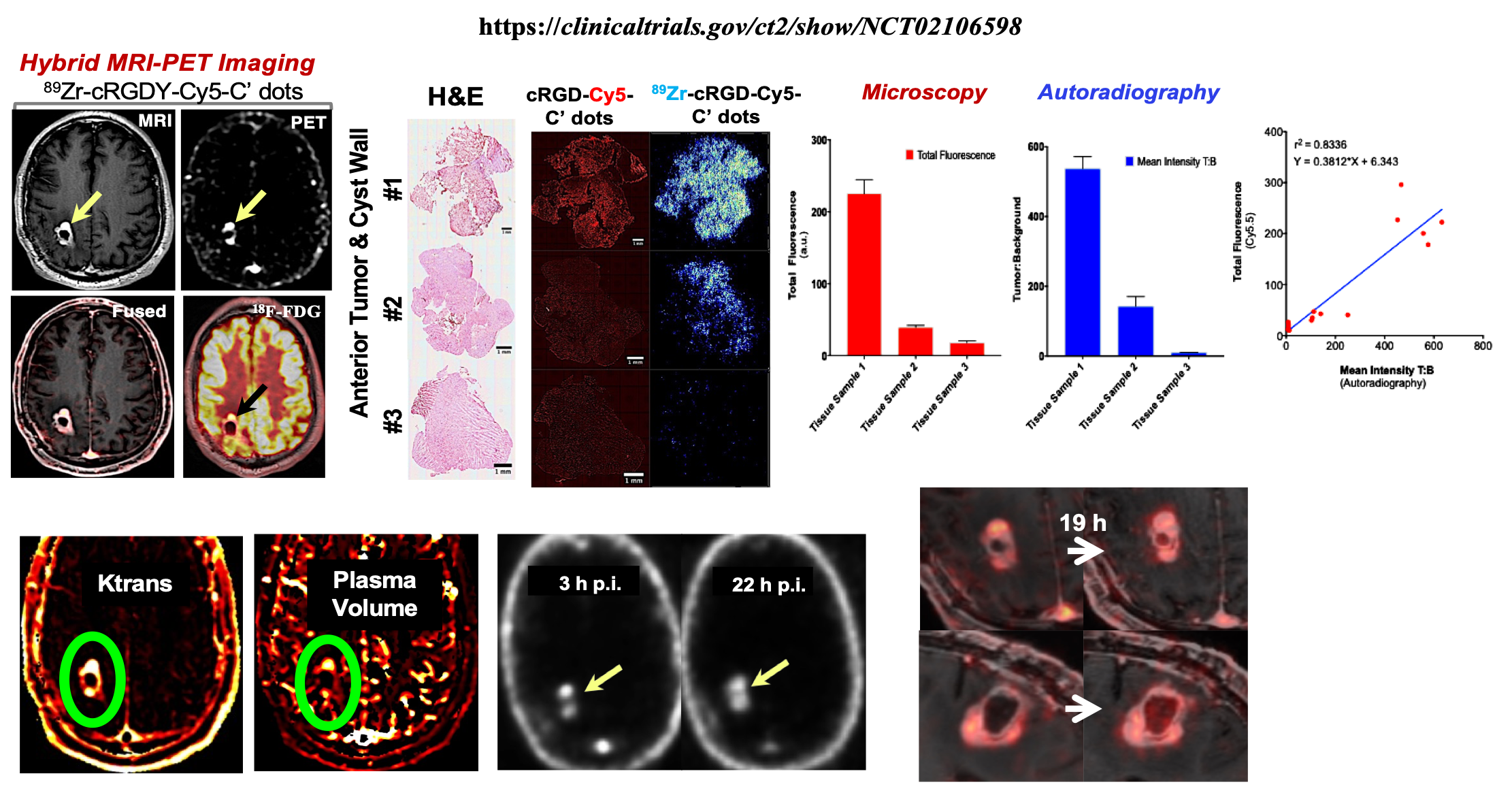
Figure 2. The integrin targeting particle tracer used in Figure 1 was also used to image malignant brain tumor patients following radiolabeling with zirconium-89 (89Zr). In this trial, the particle tracer served as a surrogate for a theranostic platforming order to assess its targeting, penetration, and diffusion properties. A representative patient shows that favorable targeted delivery, penetration, and diffusion could be achieved for this novel particle imaging agent.
Next-Gen Targeted Fluorescent Agents for Image-Guided Surgery in Head and Neck Cancer Patients
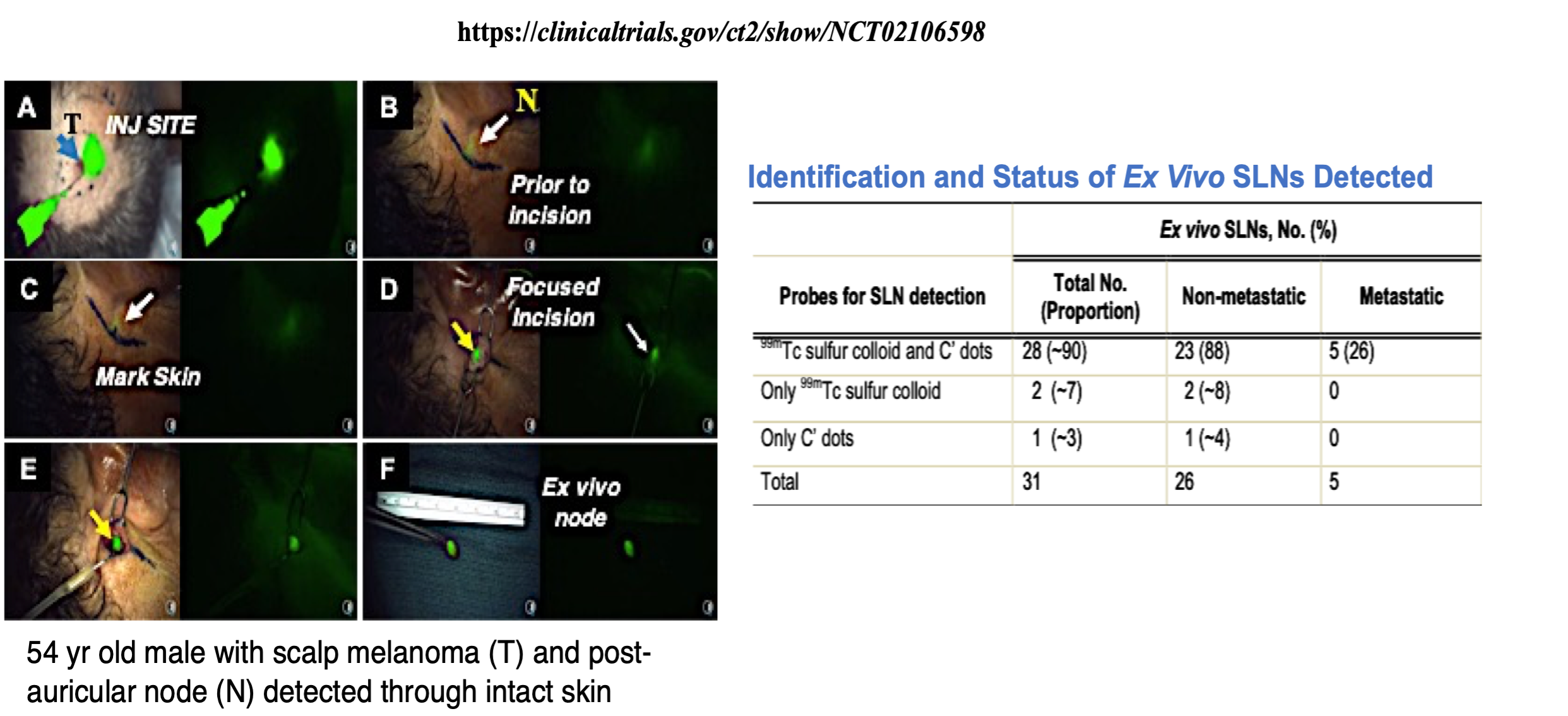
Figure 3. Results of particle tracer studies in Figure 2 were used to inform a Phase 1/2a SLNM trial in head and neck cancer patients. Typically, technetium sulfur colloid (TcSC) is the standard of care for melanoma, which cannot be visualized by the operating surgeon. The results of the study showed that C’ dots could be used as high-contrast visualization tools for reliably identifying SLNs with less exploratory surgery and more targeted disease removal. The efficacy endpoint was met, namely that the proportion of excised nodes detected was roughly equivalent for cRGD-Cy5.5-C’ dots and 99mTc SC. D.Karassawa, M. Bradbury, S. Patel et al., JAMA Netw Open. 4 (2021), e211936
Molecular Phenotyping of Metastatic Disease Using Fluorescence-Based Multiplexing and Spectrally-Distinct C’ dots
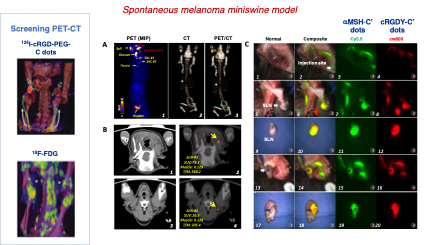
Figure 4. Using a spontaneous melanoma miniswine model, nodal metastases were molecularly phenotyped using spectrally distinct C’ dots – an integrin and MC1-R targeting platform. Each particle encapsulated a different deep/NIR dye for target-specific localization using a special camera system designed for multiplexing. Initial PET-CT screening studies conducted in this model showed better SLN detection than standard of care FDG, the latter not able to identify SLNs in 30% of animals (left, middle panels). Multiplexing studies were then carried out (right panel) showing that nodes could be specifically detected in the head and neck on PET and using both targeted probes and fluorescent-driven multiplexing.
Imaging Findings Strongly Correlate with Tumor Burden
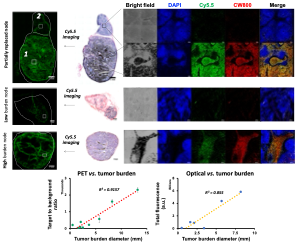
F. Chen, B. Madajewski, K. Ma, U. Wiesner, M. Bradbury, et al., Sci. Adv. 5 (2019), eaax5208
Treatment of high-grade glioma mice with DOX-C’ dots leads to significantly reduced tumor burden and proliferative activity over the native drug
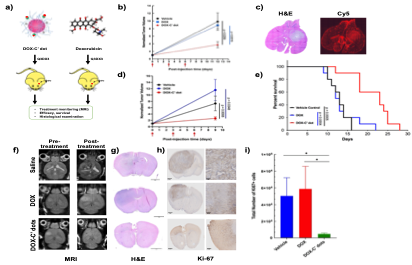
Figure 5. Doxorubicin (DOX), was conjugated to the particle surface via pH-sensitive linkers to improve therapeutic efficacy and dose-limiting toxicity of the free drug in both platelet-derived growth factor receptor (PDGFR) transgenic and EGFR (amp/mutated) PDX models. Clinically approved liposomal agents encapsulating DOX, i.e., DOXIL, generally show modest efficacy. DOX-C’ dots, DOX, or saline vehicle were i.v.-injected, with results showing that DOX-C’ dots led to substantial improvements in efficacy over the free drug, along with significant drops in proliferative activity. C’ dots were also found to abrogate cardiotoxicity in the same brain tumor model. V. Aragon, B. Yoo, P. Zanzonico, C. Rudin, C. Brennan, U. Wiesner, M. Bradbury, et al. Clin Cancer Res 2022; 28:2938-2952.
Enhanced Therapeutic Efficacy of anti-HER2-targeted SG4015-C’ dots in NCI-N87 Xenografted Mice
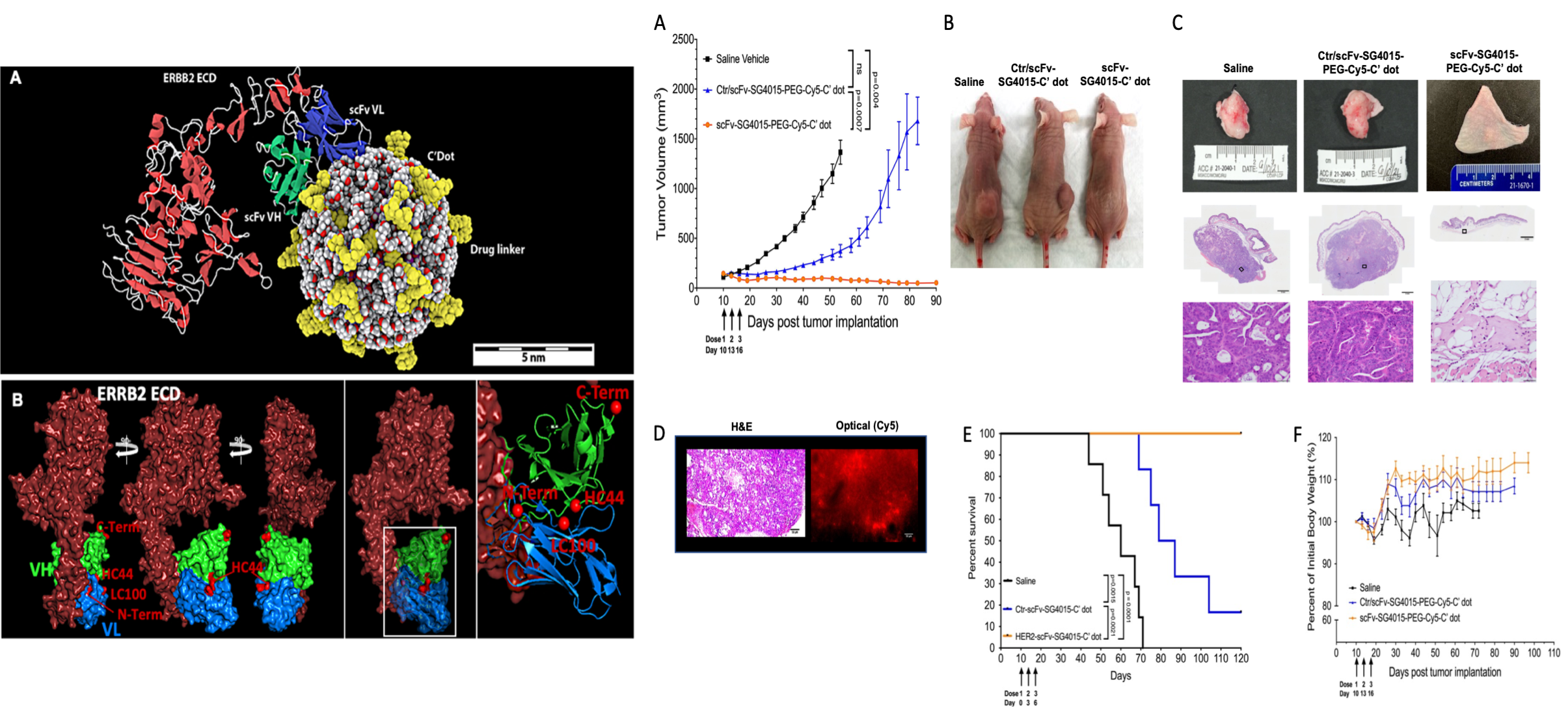
Figure 6. Site-specific engineered anti-HER2 single-chain antibody fragments were attached to C’ dots, along with a topoisomerase inhibitor, SG4015, to create C’ dot immunoconjugates for imaging and therapy. An isotype control fragment conjugated to C’ dots served as the particle control. Results showed tumor eradication of breast tumor xenografts following a multi-dose iv-injected regimen of scFv-SG4015-C’ dots without evidence of tumor recurrence, unlike findings with the control particle or saline vehicle. No animals died following use of the targeted theranostic probe and no significant weight loss was observed. Pathological examination of the small nodule identified at the site of prior tumor treatment with scFv-SG4015-C’ dots was found to be scar tissue. L. Zhang, M. Marelli, F. Chen, B. Yoo, S. Monette, U. Wiesner, JA Subramony, MS Bradbury, et al. Engineered Ultrasmall Nanoparticle Drug-Immune Conjugates with “Hit and Run” Tumor Delivery to Eradicate Gastric Cancer. Adv. Therap. 2023, 6, 2200209.


